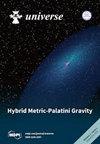作为高密度 QCD 实验室的等空间 QCD
IF 2.5
4区 物理与天体物理
Q2 ASTRONOMY & ASTROPHYSICS
引用次数: 0
摘要
具有等空位化学势 μI 的 QCD 是划分密集 QCD 中微观物理的有用实验室。为了研究夸克-介子的连续性,我们使用了一个夸克-介子模型,它在微观层面上插值了强子和夸克物质物理学。状态方程在低密度时由介子主导,但在高密度时由夸克接管。我们把以前的两味研究扩展到三味情况,研究高子(K+,K0)=(us¯,sd¯)和UA(1)反常可能带来的陌生化的影响。在正常阶段,kaon 子的激发能被μI 削弱,其方式与核物质中的超子在有限重子化学势下的方式相同。一旦小离子凝聚,kaon 的激发能量就会随着 μI 的增加而增加。此外,奇异夸克通过与凝聚的小离子的 UA(1) 耦合变得更有质量。因此,在零度和低温条件下,奇异强子和夸克被高度抑制。先前在两味模型中发现的声速峰、负痕量反常、对μI不敏感的间隙等问题,在我们的三味模型中依然存在,并且与μI∼ 1 GeV的晶格结果保持一致。我们讨论了非微扰功率修正和夸克饱和效应,它们是理解在晶格上测量到的交叉状态方程的重要因素。本文章由计算机程序翻译,如有差异,请以英文原文为准。
Isospin QCD as a Laboratory for Dense QCD
QCD with the isospin chemical potential μI is a useful laboratory to delineate the microphysics in dense QCD. To study the quark–hadron continuity, we use a quark–meson model that interpolates hadronic and quark matter physics at microscopic level. The equation of state is dominated by mesons at low density but taken over by quarks at high density. We extend our previous studies with two flavors to the three-flavor case to study the impact of the strangeness, which may be brought by kaons (K+,K0)=(us¯,sd¯) and the UA(1) anomaly. In the normal phase, the excitation energies of kaons are reduced by μI in the same way as hyperons in nuclear matter at the finite baryon chemical potential. Once pions condense, kaon excitation energies increase as μI does. Moreover, strange quarks become more massive through the UA(1) coupling to the condensed pions. Hence, at zero and low temperature, the strange hadrons and quarks are highly suppressed. The previous findings in two-flavor models, sound speed peak, negative trace anomaly, gaps insensitive to μI, persist in our three-flavor model and remain consistent with the lattice results to μI∼ 1 GeV. We discuss the non-perturbative power corrections and quark saturation effects as important ingredients to understand the crossover equations of state measured on the lattice.
求助全文
通过发布文献求助,成功后即可免费获取论文全文。
去求助
来源期刊

Universe
Physics and Astronomy-General Physics and Astronomy
CiteScore
4.30
自引率
17.20%
发文量
562
审稿时长
24.38 days
期刊介绍:
Universe (ISSN 2218-1997) is an international peer-reviewed open access journal focused on fundamental principles in physics. It publishes reviews, research papers, communications, conference reports and short notes. Our aim is to encourage scientists to publish their research results in as much detail as possible. There is no restriction on the length of the papers.
 求助内容:
求助内容: 应助结果提醒方式:
应助结果提醒方式:


